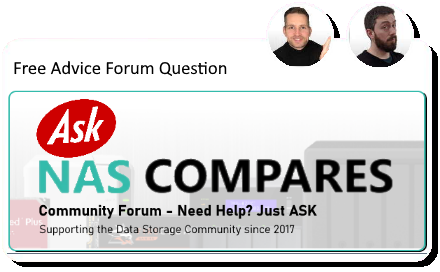08-22-2025, 02:28 PM
Here’s what I’d suggest for your needs:
NAS Software:
Go with TrueNAS SCALE. It’s open source, well-supported, and ideal for media-heavy environments. SCALE also supports SMB and NFS sharing out of the box, along with excellent ZFS integration for data safety. You don’t need Synology-style apps, and TrueNAS gives you powerful storage management and snapshots without the cost.
Filesystem:
Use ZFS. It’s the most stable and resilient filesystem for NAS use today. It’s copy-on-write, supports snapshots, self-healing, scrubbing, and strong redundancy — perfect for a shared editing pool.
RAID Configuration:
If you’re aiming for 20TB usable, you’ll probably need around 6 x 6TB or 5 x 8TB drives. I recommend:
• RAIDZ2 (ZFS equivalent of RAID 6) for best balance of performance and safety. You can lose 2 drives without losing data.
• If speed is more important and you’re okay with slightly less redundancy, RAIDZ1 (single-parity) can give you more usable space but is less fault-tolerant.
Protocol (for editing):
• SMB is your best bet. It works natively on both Windows and macOS, and it’s ideal for large files (RAWs, video).
• iSCSI is better for block-level access or mounting as a local drive, but it’s more complex to set up and maintain. For direct editing by multiple users, SMB is simpler and well-optimized.
Additional Tips:
• Use 2 x SSDs (mirror) as a boot pool or system apps/cache if your board supports it. This can help with read/write burst performance.
• Set up regular snapshots and replication, even locally, so you always have rollback options.
• If using HDDs, consider ZFS compression (lz4) — it won’t hurt performance and saves space.
NAS Software:
Go with TrueNAS SCALE. It’s open source, well-supported, and ideal for media-heavy environments. SCALE also supports SMB and NFS sharing out of the box, along with excellent ZFS integration for data safety. You don’t need Synology-style apps, and TrueNAS gives you powerful storage management and snapshots without the cost.
Filesystem:
Use ZFS. It’s the most stable and resilient filesystem for NAS use today. It’s copy-on-write, supports snapshots, self-healing, scrubbing, and strong redundancy — perfect for a shared editing pool.
RAID Configuration:
If you’re aiming for 20TB usable, you’ll probably need around 6 x 6TB or 5 x 8TB drives. I recommend:
• RAIDZ2 (ZFS equivalent of RAID 6) for best balance of performance and safety. You can lose 2 drives without losing data.
• If speed is more important and you’re okay with slightly less redundancy, RAIDZ1 (single-parity) can give you more usable space but is less fault-tolerant.
Protocol (for editing):
• SMB is your best bet. It works natively on both Windows and macOS, and it’s ideal for large files (RAWs, video).
• iSCSI is better for block-level access or mounting as a local drive, but it’s more complex to set up and maintain. For direct editing by multiple users, SMB is simpler and well-optimized.
Additional Tips:
• Use 2 x SSDs (mirror) as a boot pool or system apps/cache if your board supports it. This can help with read/write burst performance.
• Set up regular snapshots and replication, even locally, so you always have rollback options.
• If using HDDs, consider ZFS compression (lz4) — it won’t hurt performance and saves space.





